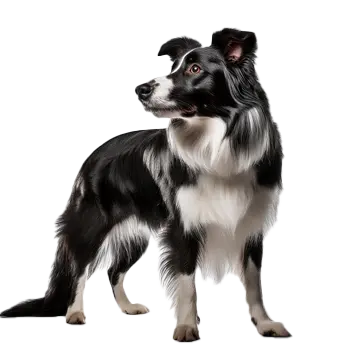Borgi
Hybrid Breed Description
The Borgi is a cross between the Border Collie and the Welsh Corgi. Because each hybrid inherits a unique combination of traits from both parents, we recommend thoroughly researching both breeds before choosing a Borgi. Pay special attention to temperament, health issues, and care requirements, as your dog may express characteristics from either parent breed.
Border Collie

The Border Collie is a medium-sized herding breed that displays remarkable athletic ability within a lean yet muscular frame. Males typically stand between nineteen and twenty-two inches at the shoulder, weighing approximately thirty to forty-five pounds, while females measure slightly smaller at eighteen to twenty-one inches and weigh between twenty-seven and forty-two pounds. This breed exhibits a well-proportioned body that is slightly longer than it is tall, featuring a strong, straight back and a deep chest that supports their exceptional stamina and endurance during prolonged periods of work. The coat of the Border Collie comes in two distinct varieties: rough and smooth, both featuring a weather-resistant double coat. The rough-coated variety displays medium-length fur with feathering on the legs, chest, and underside, while the smooth-coated type has shorter hair distributed evenly across the body. Although black and white coloration remains the most recognizable pattern, Border Collies appear in an extensive array of colors including red, blue, chocolate, sable, and merle, often combined with white markings or tan points. Their coat colors range from solid shades to tricolor combinations, with merle and brindle patterns appearing less frequently but adding to the breed's diversity. Distinctive physical features include alert, moderately-sized ears that stand erect or semi-erect with tips that often fold forward, contributing to their keen and intelligent expression. The breed's eyes are particularly notable, typically displaying dark brown coloration, though dogs with merle coats may exhibit blue, amber, or even heterochromatic eyes. Their tail extends to a moderate length with an upward curve at the tip, carried low during rest but rising when the dog is alert or engaged in activity. The Border Collie's overall appearance reflects their heritage as tireless working dogs, with every aspect of their build designed for agility, speed, and the endurance necessary to work long hours across challenging terrain.
Key Characteristics
Border Collies are widely recognized as one of the most intelligent dog breeds, possessing exceptional problem-solving abilities and an extraordinary capacity to learn commands and complex tasks with remarkable speed. This high intelligence requires substantial mental stimulation, as Border Collies become bored easily and may develop destructive behaviors when their cognitive needs are not met. Their herding heritage has instilled a strong work ethic and intense focus, manifesting in their characteristic "herding eye," a penetrating stare used to control livestock. These dogs thrive on having jobs and excel in canine sports including agility, obedience trials, and flyball. The breed exhibits tremendous energy levels requiring extensive daily exercise, both physical and mental, to maintain balanced behavior. Without adequate outlets, Border Collies may engage in excessive barking, digging, chasing vehicles, or attempting to herd children and pets. They form deep, loyal bonds with their families and are typically affectionate and devoted, often selecting one person as their primary companion. Early socialization is essential, as Border Collies can be reserved around strangers if not properly exposed to various people and environments during development. While generally not aggressive, Border Collies possess strong protective instincts toward their family and territory, making them effective watchdogs. Their sensitivity to human emotions and body language makes them highly responsive to training, though they can be strong-willed and independent thinkers who may challenge inexperienced handlers. The Border Collie's combination of intelligence, work drive, and high energy makes them best suited for active families who can provide substantial physical exercise, mental challenges, and consistent training.
Border Collies are generally regarded as a healthy and robust breed with a typical lifespan of twelve to fifteen years, though they can be predisposed to several genetic health conditions. Hip dysplasia represents one of the most significant concerns, occurring when the hip joint develops abnormally, leading to instability, discomfort, and eventually arthritis. This condition can be influenced by genetic factors as well as environmental elements such as rapid growth rates, excessive exercise during puppyhood, and maintaining an unhealthy weight. Collie Eye Anomaly, an inherited developmental disorder affecting the choroid, retina, and optic nerve, appears with varying severity from mild vision impairment to complete blindness. Epilepsy occurs with relatively high frequency in Border Collies, typically manifesting as idiopathic seizures that may begin appearing between six months and five years of age. Progressive Retinal Atrophy, though less common in working lines, causes gradual deterioration of the retina potentially leading to total blindness. Additionally, the breed may develop Trapped Neutrophil Syndrome, a genetic immune system disorder that compromises infection-fighting ability, and Neuronal Ceroid Lipofuscinosis, a fatal neurological condition typically presenting around fifteen to twenty months of age. Other health concerns include osteochondritis dissecans, a developmental joint disease affecting the shoulder during rapid growth phases, and Border Collie Collapse, characterized by episodes of disorientation and weakness following intense exercise. Responsible breeding practices, including health screenings for hip dysplasia, eye conditions, and genetic testing for inherited disorders, can significantly reduce the incidence of these conditions. Regular veterinary examinations, maintaining appropriate weight, and monitoring for early signs of health issues are essential for ensuring Border Collies live long, healthy lives.
Welsh Corgi

The Welsh Corgi is a small herding breed characterized by its distinctive chondrodysplastic body structure, featuring a long, sturdy torso set upon short, slightly bowed legs that developed through selective breeding for working cattle. The Pembroke Welsh Corgi, the more popular of the two Corgi varieties, typically stands ten to twelve inches tall at the shoulder and weighs between twenty-three and twenty-eight pounds, with females generally being slightly smaller than males. These dogs display a body that is noticeably longer than it is tall, with a straight, level back and deep chest that provides surprising athletic capability despite their compact stature. The breed reaches full size around one year of age, though some individuals continue filling out until two or three years old. The Corgi's double coat is weather-resistant, featuring a short to medium-length outer layer with a dense undercoat that provides protection from harsh conditions while requiring regular grooming, particularly during seasonal shedding periods. Color variations include rich red, fawn, sable, and black, often combined with white markings that typically appear on the legs, chest, neck, and face. Tricolor combinations of black, white, and tan are common, with head coloration ranging from red to black. Occasionally, a fluffy-coated Corgi appears in litters, displaying longer, softer fur with more pronounced feathering, though this coat type differs from the breed standard. The Pembroke variety traditionally has a very short tail, either naturally bobbed or docked, distinguishing it from the Cardigan variety which sports a longer, fox-like tail. Physical features include firm, medium-sized ears that stand erect and taper to slightly rounded points, proportionate to the wedge-shaped head that exhibits a fox-like appearance. Their oval-shaped eyes convey an intelligent, alert expression and typically appear dark in color. The skull is fairly broad and flat between the ears, with a moderate stop and a muzzle that tapers slightly toward the tip. Despite their low-to-ground build, Welsh Corgis possess remarkable agility and speed, originally developed to enable them to nip at the heels of cattle while ducking beneath kicks, making them surprisingly athletic dogs capable of excelling in various canine sports including herding trials, agility competitions, and obedience events.
Key Characteristics
Welsh Corgis are renowned for their quick intelligence and strong-willed personality that reflects their heritage as independent-thinking farm dogs. These dogs possess sharp minds that make them fast learners and excellent problem solvers, though this intelligence also means they can become mischievous if not given adequate mental stimulation and firm training. Corgis view themselves as big dogs in small bodies and approach life with remarkable confidence, traits that served them well when herding cattle. Their active, animated nature means they never want to be left out of family activities and thrive when given jobs to perform. The breed exhibits moderate to high energy levels and requires regular daily exercise to maintain both physical and mental well-being, as insufficient activity can lead to excessive barking, digging, destructive chewing, and weight gain. Corgis are intensely people-oriented and form deep bonds with their families, displaying unwavering loyalty while often selecting a favorite person. Their attachment means they do not tolerate extended isolation and can develop separation anxiety. The herding instinct remains strong, and without proper training, Corgis may attempt to herd children or pets by nipping at heels or using vocal corrections. While generally friendly and good with children when properly socialized from an early age, Welsh Corgis can be reserved with strangers initially, making them excellent watchdogs who readily announce visitors with their surprisingly large bark. Corgis possess independent minds and can display stubborn streaks, making early establishment of household rules essential. Despite their bossy nature, these dogs are sensitive to harsh corrections and respond best to positive reinforcement methods. Their combination of intelligence, loyalty, and strong personality makes them wonderful companions for owners who can provide structure, exercise, and firm but kind leadership.
Welsh Corgis are generally healthy dogs with a typical lifespan of twelve to fifteen years, though their chondrodysplastic body structure predisposes them to several breed-specific health conditions related to their long spine and short legs. Intervertebral Disc Disease represents one of the most significant concerns, occurring when cushioning discs between vertebrae degenerate or herniate, placing pressure on the spinal cord and potentially causing pain, weakness, or paralysis. This condition affects Corgis at higher rates than most breeds due to the FGF4 genetic mutation that produces their shortened legs while increasing susceptibility to spinal problems. Degenerative Myelopathy, a progressive neurological disease, causes gradual spinal cord degeneration leading to hind limb weakness and eventual paralysis, typically beginning around eight years of age with no cure available. Hip dysplasia affects Corgis frequently, resulting from abnormal hip joint development causing instability, pain, and arthritis. Environmental factors including rapid growth, excessive exercise during puppyhood, and obesity can exacerbate this inherited condition. Progressive Retinal Atrophy causes gradual retina deterioration beginning with night blindness and potentially progressing to complete vision loss. Von Willebrand's Disease, a blood clotting disorder, affects some Corgis and can cause prolonged bleeding from injuries or surgeries, though genetic testing allows identification of carriers. Additional health concerns include Exercise-Induced Collapse causing muscle weakness after strenuous activity and epilepsy manifesting as seizures. Corgis have strong appetites and tendency toward obesity, which places additional stress on their vulnerable spines and joints, making weight management critically important. Responsible breeding practices incorporating health screenings and genetic testing can help reduce inherited conditions. Regular veterinary care, maintaining ideal body weight, providing appropriate exercise that minimizes jumping and stairs, and monitoring for early symptoms are essential for maximizing Welsh Corgi health.
Important to Remember
Each hybrid dog is unique and may inherit any combination of traits from either parent breed. The information above represents the characteristics of the purebred parent breeds. Your Borgi may favor one parent over the other or display a blend of both. We strongly encourage you to read the complete breed profiles for both the Border Collie and Welsh Corgi to fully understand the range of possible temperaments, health concerns, and care requirements.